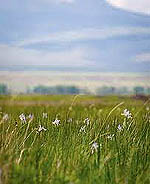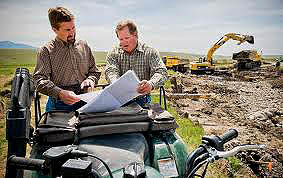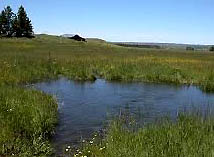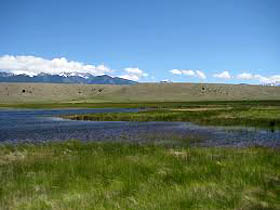“That is spectacular!” “Who owns this?” “Check out the wide-open space!” These were comments made by summer visitors to PERC, learning more more about how property rights and markets can help improve environmental quality. To bring theory outside of the classroom and into the real world, the group spends a day exploring on-the-ground examples of free market environmentalism.
One destination was the Granger Ranches owned by Jeff Laszlo (featured above). A native of New York, Laszlo came to manage the family ranch just a decade ago. That Laszlo became a rancher was no accident; childhood visits to the ranch pumped the desire to work the Montana range into his blood. But it was by accident that he became an environmentalist.
The 13,000-acre ranch sits in the middle of the Madison Valley amidst a one million-acre corridor that runs from the small town of Ennis, Montana, south to Yellowstone National Park. The valley is channeled by the Madison River and framed by the Madison and Gravelly mountain ranges. Most of the valley is privately owned, skirted by federal lands and an occasional state allotment. This area is famous for having the greatest ecological abundance in the greater Yellowstone ecosystem.
Change may be at the cusp, however, as properties like the Granger face the ever increasing pressures of rising operational costs, low returns on investment, encroaching development, wildlife, and inheritance issues. These hurdles often force the sale of large land holdings that can have dire environmental consequences by disrupting the wildlife corridors that run through the valley.
Laszlo is responding to these challenges with a push for conservation and a diversification of the values his land represents. In Laszlo’s words, “Some only see value in the forage that can be raised on the land as crops or native pasture, but I now see a new set of values that include biodiversity, habitat, water quality, and open space. As these things become rarer, the value they represent will become more precious in many ways.” In this way, Laszlo sees managing the Granger Ranches as a “balancing act between consumptive practices and preserving the land for the important biological and economic values it represents.”

INVESTING IN CONSERVATION
Conservation measures such as those taking place on the Granger Ranches are providing public benefits, but many of these benefits are provided without compensation to the private landowners who provide them. Despite these complications, Laszlo and others are investing in conservation efforts to protect their land and enhance its wildlife habitat. The Undaunted Stewardship Program in Montana is evidence of the many agricultural producers that are willing to put forth resources for wildlife conservation and the longevity of the productivity of the land. The program certifies producers who create grazing plans and continually monitor the productivity and health of their land. This provides benefits for wildlife as well as for livestock, which improves the rancher’s bottom line.
Agricultural producers are also investing in future landscapes and habitat by working with diverse groups such as land trusts and public agencies who share common goals. One tool used to ensure working lands will remain undeveloped and continue to provide open space and wildlife habitat is the conservation easement. More than 50 percent of all private land in the Madison Valley is protected from division or development. The easements on the Granger Ranches and its neighbors represent a 30,000-acre area of prime habitat and open space for wildlife.
WETLANDS REVIVAL
In the last five years, eight miles of spring-fed creeks and more than 500 acres of wetlands have been restored on the Granger. This is a big change from the miles of drainage canal excavated into the land in the 1950s to dry up swampy ground and make it more agriculturally productive. Additionally, the headwaters of O’Dell Creek, which lie in the lowlands of the Granger Ranches, were rerouted into a shallow, straight ditch that would often reach 70 degrees—a perilous temperature for native trout. This story in not unique; many wetlands were filled under government subsidy programs in the midtwentieth century to enhance production and livestock forage.

Because natural wetlands like those found on the Granger Ranches are rare and offer important habitat in the West, public agencies often help share the cost of protection and restoration. The U.S. Fish and Wildlife Service, through its Partners for Fish and Wildlife Program, has worked with the Granger Ranch to do just that. This is viewed as a win-win by both Laszlo and the federal government. It is a synergy that has enhanced both public resources and private landholdings, making them more productive.
This synergistic arm has also reached a national corporation. PPL Montana has provided millions of dollars to help fund conservation and restoration projects on both private and public lands. While this creates tremendous goodwill, it also relates to operational requirements. Relicensing a dam under the Federal Energy Regulatory Commission requires PPL to maintain minimum water flows and sets a maximum water temperature allowed on dammed rivers. Flow and temperature can be controlled by the quantity of water allowed to spill through the dam. Restoring wetlands like those on the Granger spring creek is a reliable source of cold, clean water for both wildlife and the public.
FENCES MAKE GOOD NEIGHBORS
While the ranch is not open to the general public, the restoration project that has been funded with both public and private dollars provides great benefits to the public. The 
Laszlo’s efforts to forge partnerships with private and public funders have helped enhance the sustainability of his ranch. As an “enviropreneur” who does well while doing environmental good, Laszlo has taken his family ranch in a unique direction and may be setting a new model for others to follow. As one of the tour members said, Laszlo’s ranch “exemplifies how one can increase profit by conserving environmental amenities.” And this is precisely how Laszlo became an environmentalist—by recognizing the value of his environmental amenities and managing for them.
If you are interested in visiting the Granger Ranches, contact Madison Valley Expeditions at 406-682-5667.




